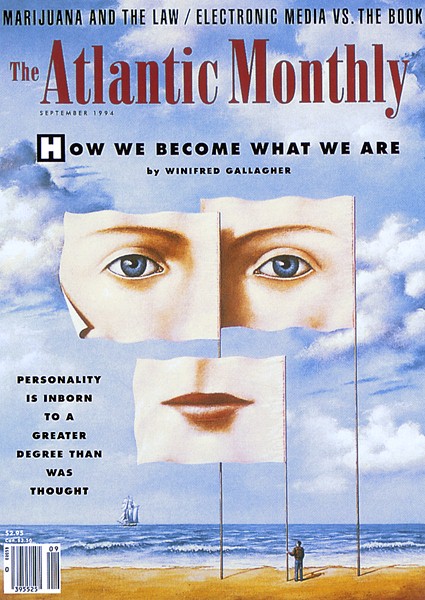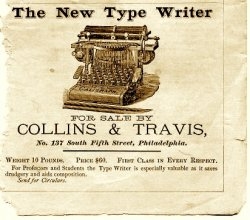
 BY JEFF DEENEY A major piece of recent news (in nerd circles, at least) is that the Atlantic Monthly has gone the way of the Grey Lady and torn down the pay wall standing between non-subscribers and the magazine’s online content. Now the magazine’s archives dating all the way back to 1857 are yours to search, post about on your blog and link friends to favorite articles you might have read a long time ago but almost totally forgot about. It’s not Alycia Lane, I know, but different things make different people’s hearts go pitter patter.
BY JEFF DEENEY A major piece of recent news (in nerd circles, at least) is that the Atlantic Monthly has gone the way of the Grey Lady and torn down the pay wall standing between non-subscribers and the magazine’s online content. Now the magazine’s archives dating all the way back to 1857 are yours to search, post about on your blog and link friends to favorite articles you might have read a long time ago but almost totally forgot about. It’s not Alycia Lane, I know, but different things make different people’s hearts go pitter patter.
A cursory search for articles of local interest turned up an interesting article from 1993 called, Philadelphia: Black Nationalism on Campus, written by then Atlantic national correspondent Nicholas Lemann. Lemann has since gone on to become a dean and professor at the Columbia University School of Journalism (the Editor will note with satisfaction that Lemann never attended journalism school). His article discusses the different perceptions of and perspectives on Black Nationalism that was to be found on campus at Temple and Penn.
on to become a dean and professor at the Columbia University School of Journalism (the Editor will note with satisfaction that Lemann never attended journalism school). His article discusses the different perceptions of and perspectives on Black Nationalism that was to be found on campus at Temple and Penn.
Lemann found that Temple, with its large population of black undergrads and being the first ever university to offer a Ph.D. in African American studies, fostered a thriving environment for young Afrocentrists whose primary concern was to avoid rejecting black culture as they scaled the socioeconomic ladder, while at the same time finding places to thrive professionally within the black community. Penn, with its smaller population of black students generally from somewhat more affluent backgrounds, fostered what some black students considered to be a white environment not hospitable to blacks, and many black students at Penn (most of whom were students in the Wharton business school) felt that their struggles to assimilate at Penn were the first on a long a long road of assimilation struggles that would meet them in the predominantly white business world after college.
What are especially illuminating are Lemann’s descriptions of the Universities and their respective communities as they stood in 1993. It makes for an interesting comparison with how the communities have since changed around the Universities, and how the Universities have used their influence to make this change happen.
Temple University is a big, state-supported school that has always catered to ambitious people from modest backgrounds. Its campus is encircled by trucks that serve every conceivable ethnic variation on the theme of the cheap, quick hot lunch, and that collectively underscore Temple’s working-class aura. Temple has what might be the largest number of black students of any predominantly white university in America — nearly 5,000 in a student body of 33,000 — and it is in North Philadelphia, a black neighborhood.
The University of Pennsylvania is an Ivy League school, much smaller, much more prosperous, and populated mainly by the children of college-educated, upper-middle-class parents; among its black students last year were the sons of William Gray, the head of the United Negro College Fund, and Harold Ford, the congressman from Memphis. Out of a total of 11,000 undergraduates, Penn has only 700 who are black. Its campus is on the edge of West Philadelphia, which is generally thought of as a black ghetto. Whereas Temple has the feeling of being part of a black neighborhood, Penn has the feeling of being threatened by a black neighborhood. Temple’s race-relations problems have a brawling, blue-collar cast — for example, the school was briefly home to a white student union that was sympathetic to David Duke’s National Association for the Advancement of White People — whereas Penn’s are played out more politely but may be more severe. Each school is home to one of the most famous black professors in the country, but the difference between them is emblematic: Penn’s black superstar is Houston Baker Jr., an English professor who, in addition to being the founder and head of Penn’s Center for the Study of Black Literature and Culture, is the current president of the leading
mainstream organization in his field, the Modern Language Association. Temple’s is Molefi Asante, the leader of the Afrocentrist movement, who is revered within his discipline and generally scorned outside it…
…Nearly all the students I met stoutly insisted that they were going to find black careers. It seemed that the students at Temple were more likely than the ones at Penn actually to do this, because many Temple graduates find work in municipal bureaucracies — school systems, welfare departments — where the work force is substantially black, whereas Penn students are likely to be headed for the professions, which are overwhelmingly white.
After the Atlantic ran Lemann’s article, The Daily Pennsylvanian responded, dismissing the claim that Penn was hostile towards black students and one of the black Penn students interviewed by Lemann accused him of taking their comments out of context.
Another fascinating article from the Atlantic archives (and also from 1993) is the mammoth, two part Story of a Gun, which follows the illegal gun trade as weapons make their way from rural Virginia along the “Iron Road” stretch of I-95 connecting DC, Baltimore, Philadelphia and New York. Unfortunately, its lede looks like it could have been pulled off a newspaper front page from last summer:
After 60,000 deaths from firearms use over the past two years, America is in a gun crisis. Yet gun laws remain weak, gunmakers continue to promote killing power, and gun dealers accept no responsibility for the criminal use of what they sell.
I guess it’s only been fifteen years, though. We’re bound to get it right eventually. Right?
Also of interest:
David Foster Wallace on right wing talk radio.
